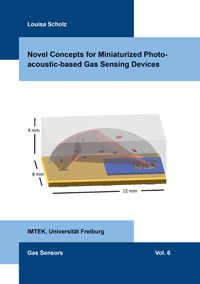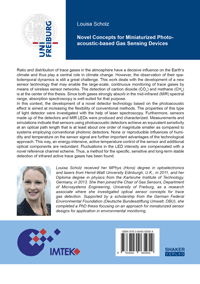
Shop : Details
Shop
Details
45,80 €ISBN 978-3-8440-6595-4Softcover140 pages67 figures206 g24 x 17 cmEnglishThesis
April 2019
Louisa Scholz
Novel Concepts for Miniaturized Photoacoustic-based Gas Sensing Devices
Ratio and distribution of trace gases in the atmosphere have a decisive influence on the Earth's climate and thus play a central role in climate change. However, the observation of their spatiotemporal dynamics is still a great challenge. This work deals with the development of a new sensor technology that may enable the large-scale, continuous monitoring of trace gases by means of wireless sensor networks. The detection of carbon dioxide (CO₂) and methane (CH₄) is at the center of this thesis. Since both gases strongly absorb in the mid-infrared (MIR) spectral range, absorption spectroscopy is well-suited for that purpose.
In this context, the development of a novel detector technology based on the photoacoustic effect is aimed at increasing the flexibility of conventional methods. The properties of this type of light detector were investigated with the help of laser spectroscopy. Furthermore, sensors made up of the detectors and MIR LEDs were produced and characterized. Measurements and simulations indicate that sensors using photoacoustic detectors achieve an equivalent sensitivity at an optical path length that is at least about one order of magnitude smaller as compared to systems employing conventional photonic detectors. None or reproducible influences of humidity and temperature on the sensor signal are further important advantages of the technological approach. This way, an energy-intensive, active temperature control of the sensor and additional optical components are redundant. Fluctuations in the LED intensity are compensated with a novel reference channel scheme. Thus, a method for the specific, sensitive and long-term stable detection of infrared active trace gases has been found.
In this context, the development of a novel detector technology based on the photoacoustic effect is aimed at increasing the flexibility of conventional methods. The properties of this type of light detector were investigated with the help of laser spectroscopy. Furthermore, sensors made up of the detectors and MIR LEDs were produced and characterized. Measurements and simulations indicate that sensors using photoacoustic detectors achieve an equivalent sensitivity at an optical path length that is at least about one order of magnitude smaller as compared to systems employing conventional photonic detectors. None or reproducible influences of humidity and temperature on the sensor signal are further important advantages of the technological approach. This way, an energy-intensive, active temperature control of the sensor and additional optical components are redundant. Fluctuations in the LED intensity are compensated with a novel reference channel scheme. Thus, a method for the specific, sensitive and long-term stable detection of infrared active trace gases has been found.
Keywords: Gas sensors; NDIR; TDLAS; photoacoustic spectroscopy; environmental monitoring
Available online documents for this title
You need Adobe Reader, to view these files. Here you will find a little help and information for downloading the PDF files.
Please note that the online documents cannot be printed or edited.
Please also see further information at: Help and Information.
Please also see further information at: Help and Information.
| Document |  | Document | ||
| Type |  | |||
| Costs |  | 34,35 € | ||
| Action |  | Purchase in obligation and download the file | ||
| Document |  | Table of contents | ||
| Type |  | |||
| Costs |  | free | ||
| Action |  | Download the file | ||
User settings for registered online customers (online documents)
You can change your address details here and access documents you have already ordered.
User
Not logged in
Export of bibliographic data
Shaker Verlag GmbH
Am Langen Graben 15a
52353 Düren
Germany
Am Langen Graben 15a
52353 Düren
Germany
Mon. - Thurs. 8:00 a.m. to 4:00 p.m.
Fri. 8:00 a.m. to 3:00 p.m.
Fri. 8:00 a.m. to 3:00 p.m.
Contact us. We will be happy to help you.



